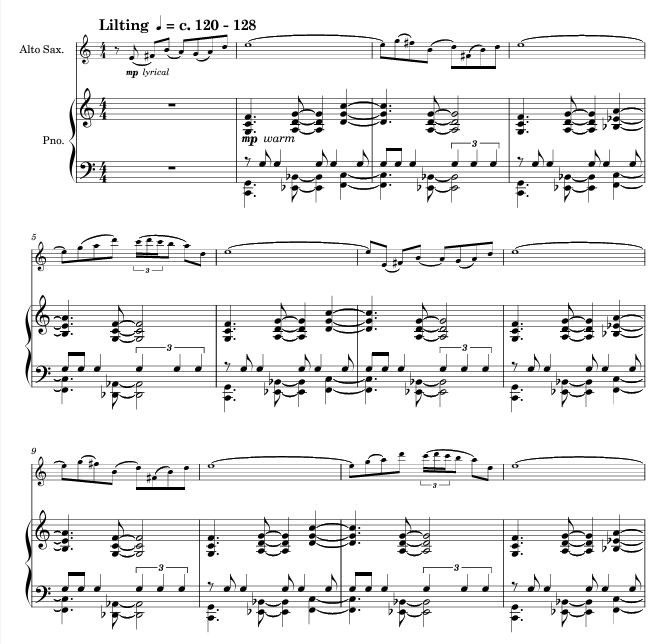A brief Analysis of the Score in terms of themes
South African influences and influences from around the world: Latin jazz, Cape jazz and Indian Classical Music
Arthur used a variety of influences in this work. Latin jazz and Indian konnakol music a feature in the third movement of this work.
Rhythm
Rhythm is a central theme in this composition, especially in the first and third movements. The rhythm is the essence of these movements as can be seen in the examples above. The third movement "Ceremonies and Dances" is especially centered around rhythm.
Programmatic elements
As explained above, each movement is based on an African folktale. Arthur used different compositional tools to recreate sound imagery from these tales. I suggested the idea to Arthur after having a discussion with my friend who mentioned that he was once invited into a sangoma's (witch doctor) home to view a piece of scaled flesh that she had obtained under mysterious circumstances. She explained that she obtained this skin when she was initiated into becoming a sangoma. To become a sangoma, one has to live in a body of water with the water goddess. This mysterious entity gifted the sangoma a piece of her flesh. There are often mystifying tales such as these in Africa.
In the first movement we can see some of this programmatism with the over-arching melodies:
In the second movement, the multiphonics, ghost notes and general dynamics are used to create a ghostly, ethereal effect.
In the third movement the konankol rhythms create a trance-like ritual which is simulated in the repeating konnakol rhythms.
Three Nocturnes from Africa, mvt 2, bars 1-5
Below I have included a snippet of these multiphonic sounds:
Introduction:
This collaboration took place from 2021 until July 2023. Feder is a well-known South African composer and lecturer at Stellenbosch University and was my theory professor in my undergraduate studies. This collaboration is a result of my previous research but was unfortunately unable to reach its full potential owing to the Covid-19 pandemic.
The Collaborative Process
In 2021, I discussed with Arthur that I wanted to work with him on a new composition for my master’s research. I began having an interest in the idea of commissioning a work. At this point in my career, I had never worked with a composer nor commissioned one. Arthur was very enthusiastic about my research and therefore agreed to write something for me.
Our first meeting took place online owing to the pandemic restrictions. This meeting took place on the 21st of April 2021. We discussed my research trajectory as well as the direction we wanted the composition to develop. I spoke about the duration as well as wanting it composed for saxophone and piano. We also discussed the possibility of it being composed for saxophone, piano and tape. For instance, I explained to Arthur that I wanted the piece to be based on African folktales. Arthur then chose the ones that resonated with him.
I decided that I wanted to perform this work in 2022 and began the preparations. However, this did not go according to plan as there were still COVID-19 restrictions on venues. I began sending a few sketches to Arthur for feedback. Here is an example of one:
I decided to postpone the premiere of the work owing to the venue and rehearsal difficulties with the restrictions.
I had another meeting with Arthur on the 6th of June 2022 to discuss any questions I had in the interpretation of the work. There was some confusion - which I will discuss in the brief analysis of the work below. This was clarified in this meeting.
Arthur and I remained in regular contact. If I had any questions about the work, I would just send him a message. Open dialogue was an important aspect of this collaboration.
My final Reflections
I really enjoyed working with Arthur. It was a fulfilling experience with a few obstacles along the way. I learnt a lot in the process. Arthur is an experienced composer in saxophone writing so the composition process was quite straightforward. The interpretation needed quite a bit of assistance which will be discussed in the ending section of these case studies. I also gained some more insight into South African Art Music through my conversations with Arthur both on and off record.
Reflections from the composer
I asked Arthur if he would classify this work as being South African and he said the following:
Yes. The narrative inspiration is from African folklore and I am born, live, work in, and teach in South Africa (Feder, 2024)
The below is taken from an interview I had with Feder earlier in 2023
Where there's this idea of trying to find a South African identity within the music, ended up with a lot of appropriation and a lot of misrepresentation of what the South African music is. And I think as composers, we live in South Africa. And we absorbed the sounds of South Africa. So, there will always be certain South African idioms that creep into our sound in general. But we also live in a globalized society. So that also means that we have access to music across the planet 24/7” (Feder, 2023).
Three Nocturnes from Africa, mvt 3, Ceremonies and Dances bars 61-66
Here one can see the inspiration from Indian konnakol music depicted by accents in the saxophone line.
Here is a sound example of this:
Three Nocturnes from Africa, mvt 2, bars 1-5
Below I have included an audio recording of this effect:
Here is an example of the sound world to which I am referring. You can hear the influences of Cape jazz from the rhythms in the piano as well as the melodic content.
Three Nocturnes from Africa, mvt 3, Ceremonies and Dances bars 160-164
Here is an example of the Latin influence in this work accompanied by a sound example below:
Arthur Feder holds an MMus in Composition (with a focus on orchestration) cum laude from Stellenbosch University. He is particularly passionate about composition, pedagogy, and the promotion of new music, and as part of the managerial team for the student initiative KOMPOS, he assisted in premiéring more than 80 orchestral and chamber works. Currently, Arthur lectures in Music Theory, Composition, and Orchestration at Stellenbosch University.
As a composer, Arthur’s multifaceted output includes work in jazz, film, mixed media and art music idioms, and he regularly receives commissions from leading ensembles and organisations in South Africa and abroad. Arthur’s film scores range from feature-length to short films, animations and documentary series. Together with his colleague, Arthur managed an annual collaboration with The Animation School in Cape Town that involved students from the Music Technology and Composition programs that garnered the production of over 20 scores for these animations. Arthur has had performances by the Axelson Nielsen duo, Sounding Cities project in Birmingham, the Stellenbosch International Chamber music festival, the Stockholm saxophone quartet, Intoga Reed quintet, Pianist Megan-Geoffrey Prins, the Stellenbosch University Big Band and Windband, the Odeion string quartet, but to name a few.
Arthur’s current focus is exploring his identity within a multicultural-multigenre playground.

















